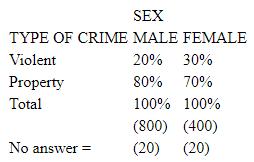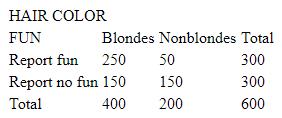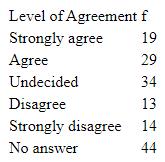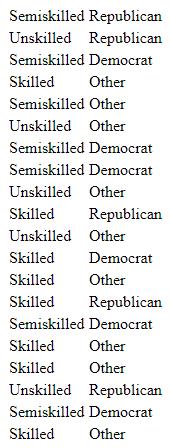Deck 14: Quantitative Data Analysis
Question
Question
Question
Question
Question
Question
Question
Question
Question
Question
Question
Question
Question
Question
Question
Question
Question
Question
Question
Question
Question
Question
Question
Question
Question
Question
Question
Question
Question
Question
Question
Question
Question
Question
Question
Question
Question
Question
Question
Question

Unlock Deck
Sign up to unlock the cards in this deck!
Unlock Deck
Unlock Deck
1/40
Play
Full screen (f)
Deck 14: Quantitative Data Analysis
1
Contingency tables can be used to present and describe:
A)bivariate and multivariate relationships.
B)univariate, bivariate, and multivariate relationships.
C)bivariate and multivariate relationships, but only using discrete data.
D)univariate relationships only.
E)multivariate relationships of only three or more variables.
A)bivariate and multivariate relationships.
B)univariate, bivariate, and multivariate relationships.
C)bivariate and multivariate relationships, but only using discrete data.
D)univariate relationships only.
E)multivariate relationships of only three or more variables.
A
2
The end product of the coding process in quantitative analysis refers to:
A)the conversion of data items into numerical codes.
B)the conversion of an attribute to a variable.
C)the assignment of a number or numeral to each questionnaire item.
D)the transfer of variables to the computer.
E)the assignment of a variable to a computer column.
A)the conversion of data items into numerical codes.
B)the conversion of an attribute to a variable.
C)the assignment of a number or numeral to each questionnaire item.
D)the transfer of variables to the computer.
E)the assignment of a variable to a computer column.
A
3
A friend showed you the following table: 
What guideline in table construction does this table violate?
A)Tables should have a succinct heading.
B)The attributes of each variable should be clearly indicated.
C)The base for percentages should be included in the table.
D)The number of missing cases should be indicated in the table.
E)The table doesn't violate any guidelines.

What guideline in table construction does this table violate?
A)Tables should have a succinct heading.
B)The attributes of each variable should be clearly indicated.
C)The base for percentages should be included in the table.
D)The number of missing cases should be indicated in the table.
E)The table doesn't violate any guidelines.
E
4
Looking at your data and frequency distribution, you find that a variable labeled LEVEL has only whole number values between 1 and 5. You can conclude that the variable is a(n):
A)continuous variable.
B)interval variable.
C)ratio variable.
D)discrete variable.
E)dichotomous variable.
A)continuous variable.
B)interval variable.
C)ratio variable.
D)discrete variable.
E)dichotomous variable.

Unlock Deck
Unlock for access to all 40 flashcards in this deck.
Unlock Deck
k this deck
5
Always include the number of cases omitted from a bivariate analysis because of missing data in the table.

Unlock Deck
Unlock for access to all 40 flashcards in this deck.
Unlock Deck
k this deck
6
Which of the following would not be an example of sociological diagnostics?
A)Robert's GPA variations while in college
B)differing income between men and women in the workforce
C)race, ethnicity, and the ability to receive a home mortgage
D)dispersions of educational funds throughout the United States
E)gender, race, ethnicity, and poverty in the United States
A)Robert's GPA variations while in college
B)differing income between men and women in the workforce
C)race, ethnicity, and the ability to receive a home mortgage
D)dispersions of educational funds throughout the United States
E)gender, race, ethnicity, and poverty in the United States

Unlock Deck
Unlock for access to all 40 flashcards in this deck.
Unlock Deck
k this deck
7
Certain guidelines should be kept in mind when coding. Among these is the following:
A)The coding scheme should be appropriate to the analysis intended in the study.
B)The coding scheme should be appropriate to the theoretical concepts being examined.
C)The reliability of the coder(s)should always be verified.
D)Code categories should be both mutually exclusive and exhaustive.
E)Code categories should not be changed once the study starts.
A)The coding scheme should be appropriate to the analysis intended in the study.
B)The coding scheme should be appropriate to the theoretical concepts being examined.
C)The reliability of the coder(s)should always be verified.
D)Code categories should be both mutually exclusive and exhaustive.
E)Code categories should not be changed once the study starts.

Unlock Deck
Unlock for access to all 40 flashcards in this deck.
Unlock Deck
k this deck
8
Which of the following statements about data entry is FALSE?
A)There are many ways to enter data on the computer.
B)Optical scan sheets can be fed into machines that convert the marks into data.
C)Data entry can sometimes occur in the process of data collection.
D)Data entry specialists can enter data from a questionnaire into a data matrix or spreadsheet.
E)Data analysis can begin before data entry has begun.
A)There are many ways to enter data on the computer.
B)Optical scan sheets can be fed into machines that convert the marks into data.
C)Data entry can sometimes occur in the process of data collection.
D)Data entry specialists can enter data from a questionnaire into a data matrix or spreadsheet.
E)Data analysis can begin before data entry has begun.

Unlock Deck
Unlock for access to all 40 flashcards in this deck.
Unlock Deck
k this deck
9
Coding should always begin with a relatively well-developed coding scheme derived from your research purpose.

Unlock Deck
Unlock for access to all 40 flashcards in this deck.
Unlock Deck
k this deck
10
A description of the number of times that the various attributes of a variable are observed in a sample is called a _____.
A)frequency distribution
B)mean
C)measure of dispersion
D)contingency table
E)multivariable table
A)frequency distribution
B)mean
C)measure of dispersion
D)contingency table
E)multivariable table

Unlock Deck
Unlock for access to all 40 flashcards in this deck.
Unlock Deck
k this deck
11
Professor Wilton decided to test whether blondes have more fun. Wilton surveyed 600 people and obtained the following results:  The BEST way(s)to percentage this table is(are):
The BEST way(s)to percentage this table is(are):
A)within columns, down.
B)within rows, across.
C)divide each cell by 600.
D)within columns, across.
E)within rows, down.
 The BEST way(s)to percentage this table is(are):
The BEST way(s)to percentage this table is(are): A)within columns, down.
B)within rows, across.
C)divide each cell by 600.
D)within columns, across.
E)within rows, down.

Unlock Deck
Unlock for access to all 40 flashcards in this deck.
Unlock Deck
k this deck
12
You are helping code one of your professor's data. You are coding occupation and notice that there is no code for a respondent's indicated occupation. Which of the following statements would be correct in relating the problem to the professor?
A)The coding scheme for occupation is not mutually exclusive.
B)The lack of a code for this particular occupation signals a mismatch between the data and the coding scheme.
C)The coding scheme for occupation is exhaustive.
D)The coding scheme is not a good scheme.
E)The lack of a code for this particular occupation means that the response should be thrown out.
A)The coding scheme for occupation is not mutually exclusive.
B)The lack of a code for this particular occupation signals a mismatch between the data and the coding scheme.
C)The coding scheme for occupation is exhaustive.
D)The coding scheme is not a good scheme.
E)The lack of a code for this particular occupation means that the response should be thrown out.

Unlock Deck
Unlock for access to all 40 flashcards in this deck.
Unlock Deck
k this deck
13
Given the following age distribution, the mean is _____. 18, 33, 7, 32, 6, 5, 4
A)4
B)7
C)15
D)32
E)cannot be computed from the information given
A)4
B)7
C)15
D)32
E)cannot be computed from the information given

Unlock Deck
Unlock for access to all 40 flashcards in this deck.
Unlock Deck
k this deck
14
Construction of explanatory bivariate tables involves:
A)dividing cases into the appropriate subgroups, describing each subgroup in terms of a given variable, and comparing those descriptions across subgroups.
B)dividing, describing, and comparing subgroups on independent and dependent variables.
C)analyzing the simultaneous relationships among several variables among subgroups.
D)dividing, describing, and comparing univariate independent variables on subgroups.
E)analyzing the simultaneous relationships among several variables.
A)dividing cases into the appropriate subgroups, describing each subgroup in terms of a given variable, and comparing those descriptions across subgroups.
B)dividing, describing, and comparing subgroups on independent and dependent variables.
C)analyzing the simultaneous relationships among several variables among subgroups.
D)dividing, describing, and comparing univariate independent variables on subgroups.
E)analyzing the simultaneous relationships among several variables.

Unlock Deck
Unlock for access to all 40 flashcards in this deck.
Unlock Deck
k this deck
15
In a perfect normal distribution:
A)the mean is zero.
B)the mode is exactly half of the mean.
C)the mean, median, and mode are all equal.
D)the median is always 1.
E)the mode is twice the mean.
A)the mean is zero.
B)the mode is exactly half of the mean.
C)the mean, median, and mode are all equal.
D)the median is always 1.
E)the mode is twice the mean.

Unlock Deck
Unlock for access to all 40 flashcards in this deck.
Unlock Deck
k this deck
16
A measure of dispersion describes:
A)the clustered data.
B)the data that are most important.
C)the distribution of values around some central value.
D)the appropriate data for analysis.
E)the discrete data only.
A)the clustered data.
B)the data that are most important.
C)the distribution of values around some central value.
D)the appropriate data for analysis.
E)the discrete data only.

Unlock Deck
Unlock for access to all 40 flashcards in this deck.
Unlock Deck
k this deck
17
Whereas univariate analysis and subgroup comparisons focus on the descriptions of the people under study, the focus of most of the bivariate analysis is on the relationships among the variables themselves.

Unlock Deck
Unlock for access to all 40 flashcards in this deck.
Unlock Deck
k this deck
18
Given a mean of 12 and a standard deviation of 2, we can conclude that:
A)95 percent of cases are between 10 and 14.
B)68 percent of cases are between 10 and 14.
C)all of our data are between 10 and 14.
D)there is not enough information to make any conclusions.
E)95 percent of cases are between 11 and 13.
A)95 percent of cases are between 10 and 14.
B)68 percent of cases are between 10 and 14.
C)all of our data are between 10 and 14.
D)there is not enough information to make any conclusions.
E)95 percent of cases are between 11 and 13.

Unlock Deck
Unlock for access to all 40 flashcards in this deck.
Unlock Deck
k this deck
19
When summarizing heavily skewed data, the best measure of central tendency is:
A)median.
B)mean.
C)mode.
D)standard deviation.
E)correlation.
A)median.
B)mean.
C)mode.
D)standard deviation.
E)correlation.

Unlock Deck
Unlock for access to all 40 flashcards in this deck.
Unlock Deck
k this deck
20
Given the following age distribution, the range is _____. 12, 15, 8, 17, 34, 43, 2, 16, 43, 3
A)12 to 3
B)17 to 43
C)2 to 17
D)2 to 43
E)cannot be computed from the information given
A)12 to 3
B)17 to 43
C)2 to 17
D)2 to 43
E)cannot be computed from the information given

Unlock Deck
Unlock for access to all 40 flashcards in this deck.
Unlock Deck
k this deck
21
Bivariate and multivariate analyses use dependent variables to explain independent variables.

Unlock Deck
Unlock for access to all 40 flashcards in this deck.
Unlock Deck
k this deck
22
The College of Arts and Science at Delta University has nine departments. The number of faculty in each department is shown below. What is the median number of faculty in the College of Arts and Science? 8, 12, 9, 15, 17, 11, 13, 14, 7
A)12
B)17
C)4.5
D)5
E)there is no median in these data
A)12
B)17
C)4.5
D)5
E)there is no median in these data

Unlock Deck
Unlock for access to all 40 flashcards in this deck.
Unlock Deck
k this deck
23
Marco wants to conduct a research study to determine if students living on campus feel more or less safe than those who live off campus. At the most basic level, he should use _____.
A)univariate analysis
B)bivariate analysis
C)multivariate analysis
D)standard deviation
E)qualitative analysis
A)univariate analysis
B)bivariate analysis
C)multivariate analysis
D)standard deviation
E)qualitative analysis

Unlock Deck
Unlock for access to all 40 flashcards in this deck.
Unlock Deck
k this deck
24
An example of multivariate analysis would be:
A)an analysis of the ages of all women who are corporate executives.
B)an analysis of the relationship between age, sex, and type of nightspot frequented in a given city in the Midwest.
C)an analysis of the relationship that exists between types of undergraduate major and positions held in business.
D)an analysis of the relationship between type of offense and length of prison sentence for those who had a jury trial.
E)an analysis of the occupations of all the members of a book group.
A)an analysis of the ages of all women who are corporate executives.
B)an analysis of the relationship between age, sex, and type of nightspot frequented in a given city in the Midwest.
C)an analysis of the relationship that exists between types of undergraduate major and positions held in business.
D)an analysis of the relationship between type of offense and length of prison sentence for those who had a jury trial.
E)an analysis of the occupations of all the members of a book group.

Unlock Deck
Unlock for access to all 40 flashcards in this deck.
Unlock Deck
k this deck
25
A random sample of sociology majors at the University of Methods were asked a series of questions about their major advisor. Interpret their answers to the following question: "My advisor encourages me to see him/her."



Unlock Deck
Unlock for access to all 40 flashcards in this deck.
Unlock Deck
k this deck
26
Some believe that quantitative studies are less susceptible to subjective biases and ethical problems. Please discuss the steps that quantitative researchers should take to avoid bias and other ethical problems in their data collection and analysis.

Unlock Deck
Unlock for access to all 40 flashcards in this deck.
Unlock Deck
k this deck
27
The College of Arts and Science at Delta University has nine departments. The number of faculty in each department is shown below. What is the mean number of faculty in the College of Arts and Science? 8, 12, 9, 15, 17, 11, 13, 14, 7
A)12
B)17
C)10.7
D)11.8
E)There is no mean for these data
A)12
B)17
C)10.7
D)11.8
E)There is no mean for these data

Unlock Deck
Unlock for access to all 40 flashcards in this deck.
Unlock Deck
k this deck
28
A bivariate table is read by comparing the independent variable subgroups with one another in terms of a given attribute of the dependent variable.

Unlock Deck
Unlock for access to all 40 flashcards in this deck.
Unlock Deck
k this deck
29
A researcher believes that a person's occupation affects his or her political party preference. Given the following data on occupation and political party preference, construct a contingency table. Percentage the table and interpret your results.



Unlock Deck
Unlock for access to all 40 flashcards in this deck.
Unlock Deck
k this deck
30
The mean is a particularly useful statistic when there is great disparity in a distribution.

Unlock Deck
Unlock for access to all 40 flashcards in this deck.
Unlock Deck
k this deck
31
Explain the measures of univariate variable description that we have. What do these measures tell us? Why are they useful?

Unlock Deck
Unlock for access to all 40 flashcards in this deck.
Unlock Deck
k this deck
32
A codebook contains the following information:  Which statement concerning the codebook is TRUE?
Which statement concerning the codebook is TRUE?
A)The codebook contains three variables.
B)ID number has been coded so that the categories are mutually exclusive but not exhaustive.
C)Class standing has been coded so that the categories are mutually exclusive and exhaustive.
D)The codebook contains four variables.
E)ID number has been coded so that the categories are exhaustive but not mutually exclusive.
 Which statement concerning the codebook is TRUE?
Which statement concerning the codebook is TRUE? A)The codebook contains three variables.
B)ID number has been coded so that the categories are mutually exclusive but not exhaustive.
C)Class standing has been coded so that the categories are mutually exclusive and exhaustive.
D)The codebook contains four variables.
E)ID number has been coded so that the categories are exhaustive but not mutually exclusive.

Unlock Deck
Unlock for access to all 40 flashcards in this deck.
Unlock Deck
k this deck
33
A codebook contains the following information: 
Following this codebook, an individual assigned the number 283921 is:
A)the 2839th participant that is female residing in New York.
B)the 2839th participant that is male residing in Boston.
C)a female participant residing in Boston assigned the ID number 2839.
D)a male participant residing in New York.
E)a female participant residing in New York.

Following this codebook, an individual assigned the number 283921 is:
A)the 2839th participant that is female residing in New York.
B)the 2839th participant that is male residing in Boston.
C)a female participant residing in Boston assigned the ID number 2839.
D)a male participant residing in New York.
E)a female participant residing in New York.

Unlock Deck
Unlock for access to all 40 flashcards in this deck.
Unlock Deck
k this deck
34
When coding and analyzing data, you always want to have your numbers as specific as possible.

Unlock Deck
Unlock for access to all 40 flashcards in this deck.
Unlock Deck
k this deck
35
The most frequently occurring attribute, in either grouped or ungrouped data, is the _____.
A)mean
B)median
C)mode
D)range
E)marginal
A)mean
B)median
C)mode
D)range
E)marginal

Unlock Deck
Unlock for access to all 40 flashcards in this deck.
Unlock Deck
k this deck
36
In multivariate analysis a second dependent variable is added.

Unlock Deck
Unlock for access to all 40 flashcards in this deck.
Unlock Deck
k this deck
37
What is a codebook? Construct a codebook for the following questionnaire items. a. Sex (1)Male (2)Female b. Age at last birthday c. How many brothers and sisters do you have? (Count only those who are now alive. Include stepbrothers and stepsisters and children adopted by your parents.) d. What is your current marital status? (1)Married (2)Widowed (3)Divorced (4)Separated (5)Never married

Unlock Deck
Unlock for access to all 40 flashcards in this deck.
Unlock Deck
k this deck
38
Which of the following measures of central tendency can be used for any level of measurement?
A)Mean
B)Mode
C)Median
D)Standard deviation
E)Range
A)Mean
B)Mode
C)Median
D)Standard deviation
E)Range

Unlock Deck
Unlock for access to all 40 flashcards in this deck.
Unlock Deck
k this deck
39
The "don't know" category should always be excluded from analysis.

Unlock Deck
Unlock for access to all 40 flashcards in this deck.
Unlock Deck
k this deck
40
Bivariate and multivariate analyses are aimed primarily at explanation.

Unlock Deck
Unlock for access to all 40 flashcards in this deck.
Unlock Deck
k this deck



